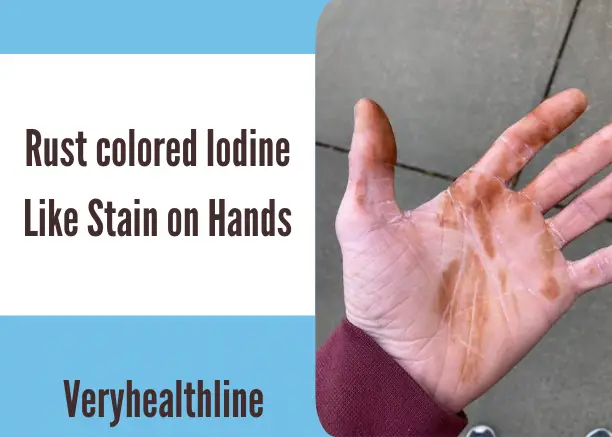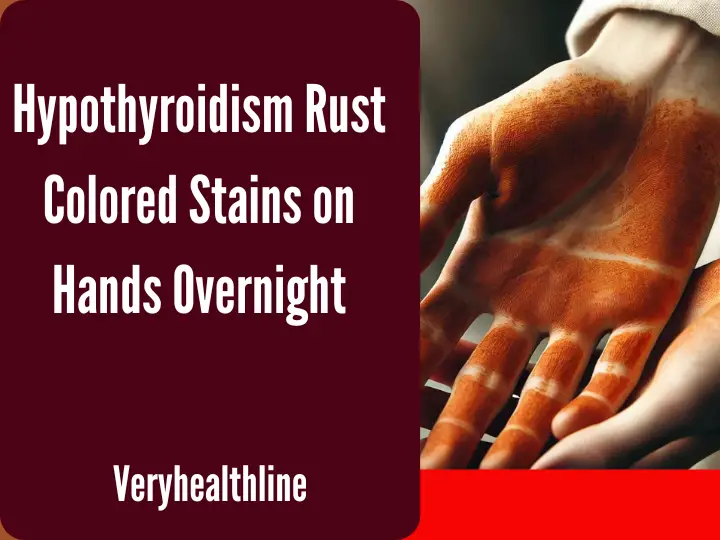Rust colored Iodine Like Stain on Hands

Have you ever noticed rust-colored stains on your hands that look strangely similar to iodine? You’re not alone. These mysterious stains can be baffling, especially when they seem to appear out of nowhere. Whether from contact with metals, exposure to chemicals, or handling iodine-based solutions, these stains can be unsettling and sometimes difficult to remove. If you are experiencing skin irritation or discoloration due to stains or other issues, AMERIGEL Hydrogel Dressing can help soothe and treat your skin effectively.
In this article, we will explore the causes of these rust-colored, iodine-like stains on hands, how to prevent them, effective removal methods, and when you should be concerned. Let’s dive into the common reasons for this unusual discoloration and ways to tackle the problem.
What Is Hemosiderin Staining?
Have you ever noticed a rust-colored patch or bruise-like stain on your skin, especially on your hands? This type of discoloration can be tricky to spot, especially on darker skin tones, as it may appear brownish, black, or even harder to distinguish from the surrounding skin. While these stains often show up on the lower legs, near the ankles, or feet, they can also occur on the hands.
This happens when blood leaks out of small vessels called capillaries, pooling under the skin and leaving a residue of hemoglobin, which settles in the tissue. Since hemoglobin contains iron, it is the iron that causes the rusty color of the stains.
Hemoglobin is a protein molecule in your red blood cells that is responsible for carrying oxygen from your lungs to your body’s tissues. When red blood cells break down, they release iron, which becomes trapped and stored as hemosiderin in the tissues beneath the skin.
This trapped iron can accumulate and result in yellow, brown, or black staining. Although these stains often appear on the lower legs, sometimes between the knee and ankle, the same process can cause stains on the hands, creating a similar bruise-like appearance.
Also Read: Hypothyroidism Causes Rust-Colored Hand Stains Overnight
What Causes Hemosiderin?
Rust-colored stains on the hands can be a symptom of a deeper condition involving your blood vessels. One common cause is chronic venous insufficiency (CVI), where the veins in the legs and feet struggle to return blood to the heart. This happens when the valves in the veins become weakened, allowing blood to flow backward and pool in the vessels of the legs.
Over time, this trapped blood begins to break down, releasing iron-containing cells into the tissue, which leads to hemosiderin staining. This process not only affects the legs but can sometimes cause similar stains on the hands.
Certain conditions can also trigger iron buildup in the body, especially when blood flow is compromised due to faulty blood valves in the legs. The breakdown of blood cells leads to the accumulation of iron, causing discoloration and staining of the skin.
In some cases, contact with metals like iron, copper, or brass can also transfer their pigments to the skin, creating similar stains. Additionally, chemical reactions involving iodine, certain dyes, or even medications containing iron can lead to discoloration as well.
Treatment Options for Rust-Colored Iodine-Like Stains on Hands
If you notice rust-colored or iodine-like stains on your hands, it’s important to consult a healthcare professional to get the right diagnosis. These stains could be linked to an underlying cause, and the right Treatment will depend on that.
Some common treatment options include using topical treatments like creams or ointments. These are often recommended by a healthcare provider to help reduce the appearance of the stains and promote skin healing over time.
For deeper stains, other methods like chemical peels can be used to remove the outer layer of the skin, which helps to reduce the visibility of the stains. Another option is laser therapy, which can target and break down the pigmented areas, resulting in a more even skin tone. These laser treatments are effective for more persistent cases, helping to restore a natural look to the skin.

How to Prevent Rust-Colored Stains on Hands
Preventing these stains involves taking proactive measures, especially if you’re regularly exposed to the elements that cause them.
Protective Measures in Work Environments
If your work involves handling rusty materials or chemicals, wearing protective gloves can significantly reduce the chances of stains forming on your skin.
Proper Handling of Chemicals
Always wash your hands thoroughly after using iodine-based solutions or handling metals that might rust. Using hand sanitizers and soaps with mild exfoliants can help in removing particles that could cause staining.
What to Do If You Notice Rust-Like Stains
Once you’ve spotted rust-colored stains on your hands, it’s important to act quickly to prevent them from setting in and becoming harder to remove.
Immediate Steps to Take
Start by washing your hands with soap and water immediately. If the stain persists, a more targeted cleaning method may be necessary.
Cleaning and Removing Stains
Certain home remedies and specialized products can be used to clean off rust-colored stains. Don’t be discouraged if it takes more than one wash to fully remove the stain.
Effective Remedies for Removing Rust-Colored Stains
There are a few tried-and-true methods for removing rust-colored stains from your hands. Let’s look at both home remedies and commercial solutions.
Home Remedies
Lemon and Baking Soda Mixture
Lemon is a natural bleaching agent, and baking soda is a gentle abrasive. Mixing the two can help scrub away the stain while lightening the discoloration.
Vinegar and Salt Scrub
This combination works similarly to lemon and baking soda. The acidity of the vinegar breaks down the stain, while the salt acts as a scrub to remove particles.
Commercial Cleaners and Soaps
Look for soaps and hand cleaners specifically designed to remove tough stains like rust or iodine. These are often found in hardware stores or industrial supply shops.
Medical Solutions and Skin Care Products
For stubborn stains, dermatological products designed to exfoliate and rejuvenate the skin may help. Creams containing mild acids or exfoliants can assist in lightening the stain over time.
When to See a Doctor
In some cases, rust-colored stains may indicate an underlying health issue or allergic reaction.
Persistent Staining
If a stain persists for weeks despite attempts to clean it, this could signal a more significant skin issue, and a dermatologist should be consulted.
Skin Conditions and Allergic Reactions
Staining could be a symptom of a skin condition or allergic reaction, especially if it’s accompanied by swelling, redness, or itchiness.
also serve as diagnostic tools in the medical field, providing insight into a patient’s health.
Medical Conditions Related to Skin Discoloration
Certain conditions may cause skin discoloration similar to rust stains, such as dermatitis or infections. Understanding the source of the stain is crucial for accurate diagnosis.
Diagnostic Use of Iodine Staining
Iodine staining is utilized in various medical diagnostics, such as identifying tissue changes. While it may leave stains on the skin, the diagnostic benefits often outweigh the cosmetic concerns.
Psychological Impact of Visible Stains
Visible stains can affect self-esteem and how individuals perceive themselves in social settings.
Self-Esteem and Public Perception
People may feel self-conscious about visible stains, impacting their confidence and interactions with others.
Coping with Visible Discoloration
Finding effective ways to remove stains can help mitigate their psychological effects, allowing individuals to feel more comfortable in social situations.
Conclusion
Rust-colored iodine-like stains on hands can arise from various everyday activities, particularly exposure to rusty metals or iodine-based substances. While often harmless, these stains can be an indication of underlying exposure to chemicals and should be treated with care. By employing preventive measures, effectively removing stains, and recognizing when to seek medical advice, you can keep your hands looking their best.
Remember, while rust-colored stains might seem like a mere nuisance, understanding their causes and treatments can help you manage your skin health effectively.
FAQS:
Can rust-colored stains on hands be permanent?
Most rust-colored stains are temporary and can be removed with proper cleaning methods. However, some may linger longer depending on the exposure level.
How long does it take for these stains to fade naturally?
Typically, rust-like stains can take several days to a week to fade naturally, but this can vary based on skin type and exposure.
Are there any specific industries where this is a common problem?
Yes, industries such as construction, plumbing, and metalworking often encounter these stains due to frequent handling of rusty metals and chemicals.
Is it safe to use iodine-based solutions on sensitive skin?
While iodine is generally safe, individuals with sensitive skin should conduct a patch test first and consider consulting a dermatologist before use.
What household products can prevent rust-like stains?
Using protective gloves when handling rust or chemicals, along with keeping your skin clean and moisturized, can help prevent these stains. Products like lemon juice, baking soda, and vinegar can also be effective in treating stains.





